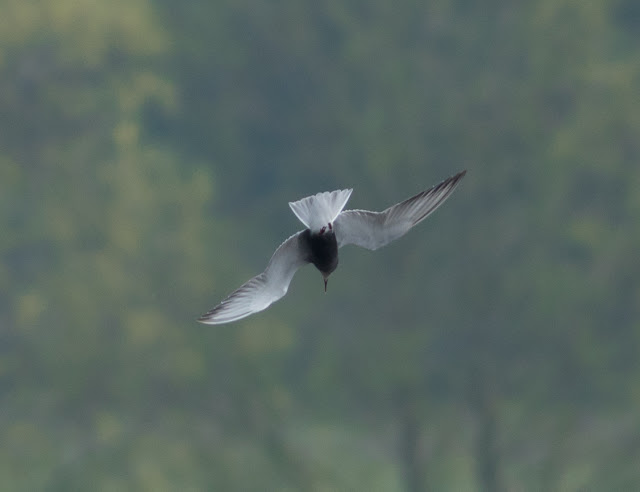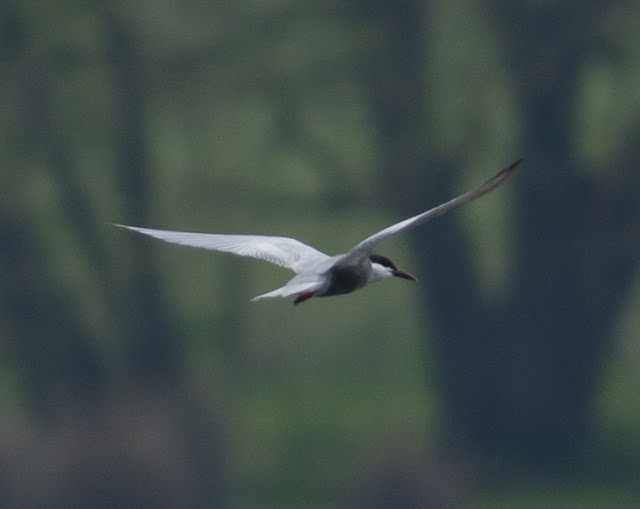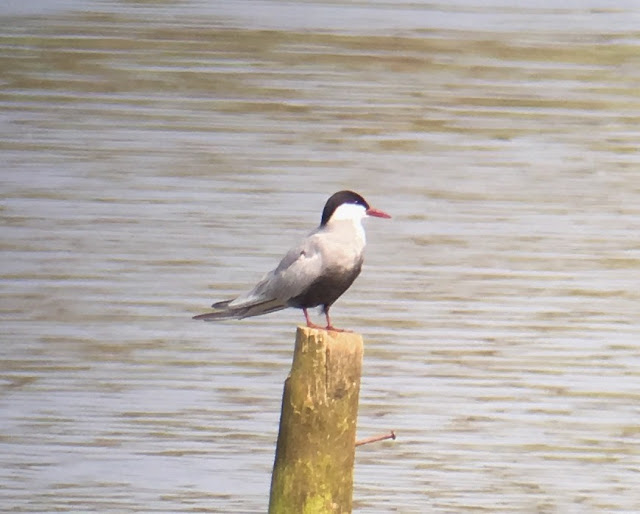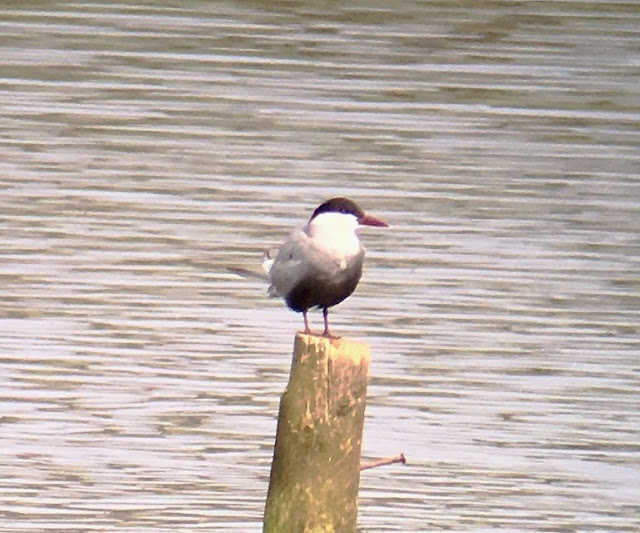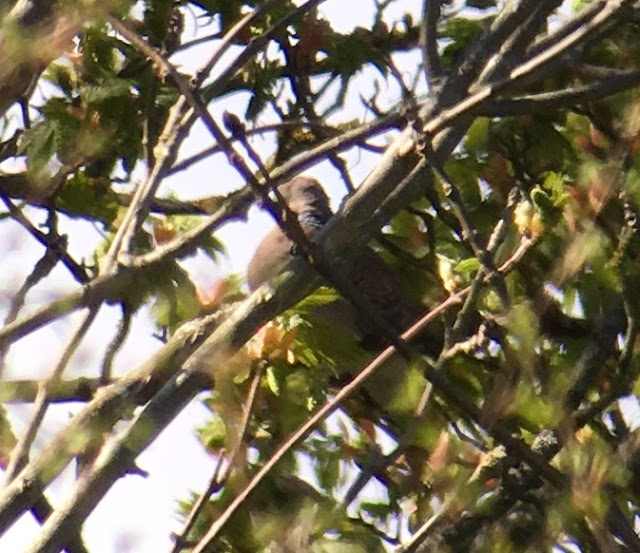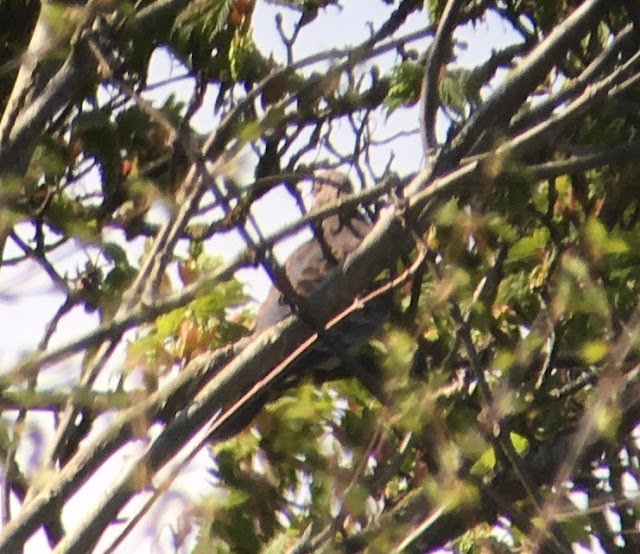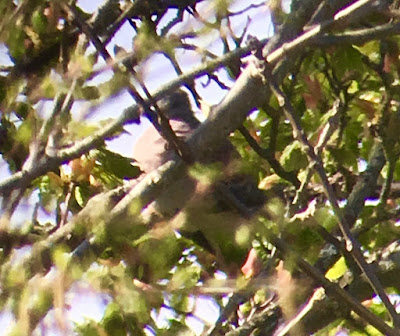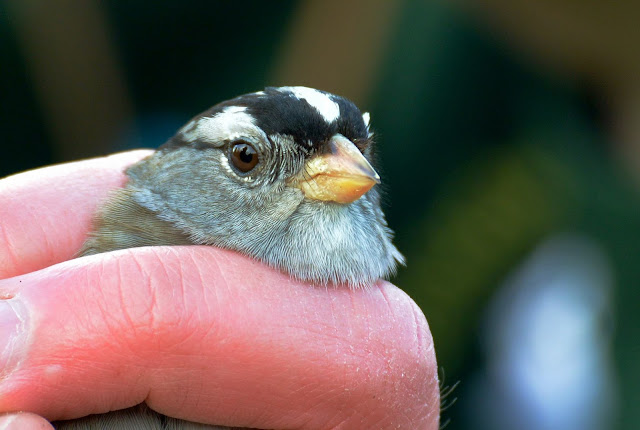"Woolston Eyes – White-crowned
Sparrow trapped and ringed, access will be arranged soon."
Still lazing in bed on the
Saturday morning, the above email message from Paul Brewster at just before
quarter past 9 soon had me leaping in to action! White-crowned Sparrow in
Cheshire?! – Mega!! Just over 20 minutes away from my house, this was a huge
bird for Cheshire, not to mention Britain, with just 5 previous records on
these shores. With well twitched individuals such as the Seaforth bird back in
October 1995 and the long staying Cley bird in 2008, this was a much needed species
for the more recent listers, and not having been actively twitching 8 years
ago, this was definitely a must-see bird, especially being so close to home.
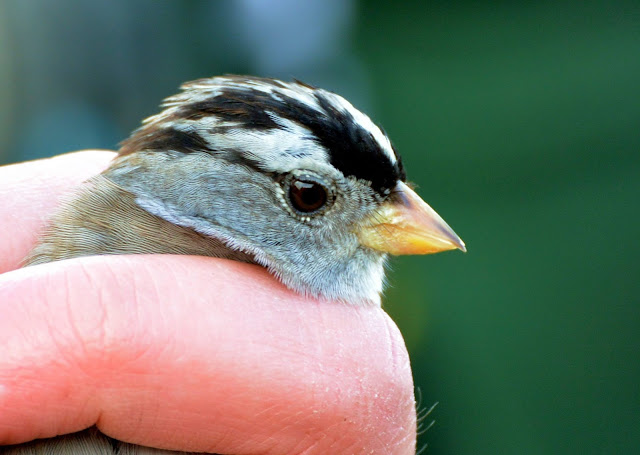 |
| David Bowman's lovely photos of the White-crowned Sparrow in the hand |
With the sparrow having been
released near the feeders at John Morgan hide and access hastily arranged for
non-permit holders, I arranged to meet Alex on site at just before 11 – having
been out on the Clwyd this was the earliest he could make it. Initially
sceptical as to whether we would be able to connect (trapped and ringed birds often
have a habit of completely vanishing once released) and with no further sign by
9:50am, the news at just after half 10 that it was back and showing well by the
feeders came as a welcome surprise – maybe we would score after all!
Having duly paid our £2 to
gain access in to the reserve and hurrying over to the hide in question, our
hopes of this attractive American sparrow happily feeding on a mass of golden
seed under the feeders and performing well for a crowd of admirers were soon
dashed – the bird had apparently gone in to hiding in a large thicket of bush
to the left hand side of the hide, and despite being just metres away from the
assembled birders, had been impossible to locate for well over an hour. In fact,
it later transpired that it was only spotted when two birders had walked in to the
bush to ascertain whether it was still there or not, and the bird had flown on to a nearby branch.
Joining the swelling crowd and
enduring frequent showers of heavy rain and hail, we kept our eyes focused on
the bush the sparrow had last been seen in, willing it to make a reappearance
and to get a glimpse of a flash of white from inside the thicket. Moving away
from the shelter of the hide and further around the spot where the sparrow was
last seen, it soon became clear that there was no movement amongst the bottom
branches or the leaf litter – the White-crowned Sparrow most definitely wasn’t
under there. Whilst everyone else was staring transfixed on the spot, I decided
to scan the surrounding bushes just in case the sparrow had taken an escape
route undetected. Turning my attention to the next bush across, I immediately
clocked several Blackcaps and Robins feeding amongst the hawthorn, while a
Chiffchaff flitted in-between the leaves.
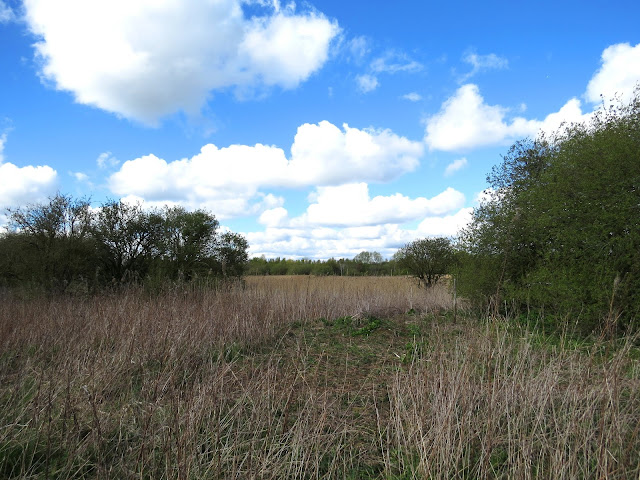 |
| The trees where the White-crowned Sparrow was hiding! |
Then, a small brown and grey
bird sat in the join of a branch soon caught my eye. Its head slightly obscured
by the tangle of Hawthorn leaves, it was hard to pick out – could it be a
Dunnock? Grey and black striped facial markings as the bird moved its head
convinced me otherwise, and as it hopped down to a lower branch and out of
view, a prominent white wing bar (looking like a string of pearls) became obvious.
This looked increasingly good - although never having seen one before and with
the crown partially obscured, I wasn’t 100% sure. Alerting Alex to get on the
spot whilst checking my Collin’s app for the finer features of White-crowned
Sparrow ID, Alex soon called out he had it – the bird had reappeared and
settled on a branch for a matter of seconds before dropping down again – just long
enough for Alex and several other nearby birders to get on it and get views of the white crown, confirming my suspicions. Fantastic!! White-crowned Sparrow in the bag!!
 |
| The finer points of White-crowned Sparrow ID! |
With many birders yet to get
on it but with our sparrow seemingly vanishing in to thin air, despite further
vigils staring in to the bush, many left disappointed, and with no further sign
throughout the afternoon and in to the next day, our sighting was seemingly the
last of this trans-Atlantic vagrant. Incredibly jammy to say the least.
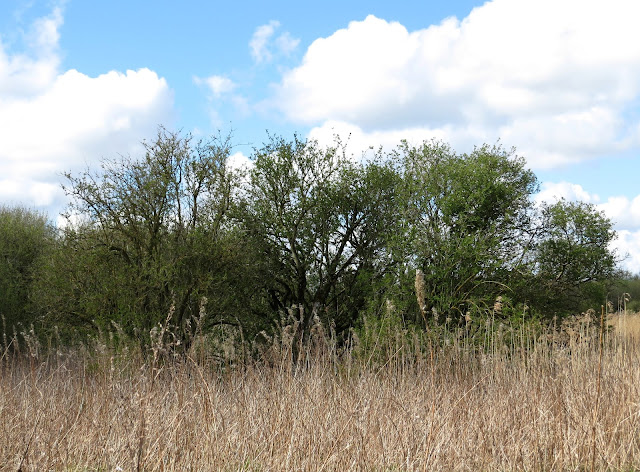 |
| The bush the sparrow disappeared into |
With the White-crowned sparrow most likely
to have found its way over to Britain last autumn during the storms, or perhaps
even elsewhere in Europe, the arrival at Woolston Eyes could well have been the
result of a natural parallel migration north - American birds would also be heading north at this time of year in their normal range. The fact that the ringers reported that it
appeared to be in a good condition when captured with plenty of muscle mass (as well as there being no particularly adverse weather during the spring originating from
across the Atlantic) would support this theory, while a first summer
Rose-breasted Grosbeak found yesterday on a feeder in Shetland only adds further
weight to this - presumably another parallel migrant on the wrong side of the ocean.
White-crowned Sparrow was
actually one of the American sparrow species we had missed on both of our
visits to the states, so it was a stroke of luck and completely unexpected to
be getting it as a lifer here in Britain! With lengthy gaps between records, it
could be some time yet before Britain scores another, especially one minutes
away from my house, so we both felt extremely fortunate to see it – albeit briefly
– and it was refreshing to get our first mega of 2016. Woolston Eyes was also a fantastic reserve to visit, and with this only being my second visit (the first was for an escaped Bufflehead last year), I may well look in to investing in a permit for future trips.


